

Metal detecting holidays in England with the World's most successful metal detecting club.
Twinned with Midwest Historical Research Society USA
|
Oct
2005 Latest Finds Page
|
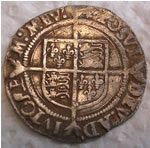 |
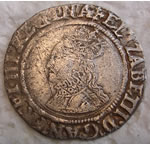 |
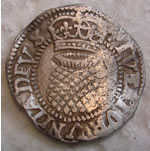 |
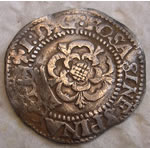 |
|
1560-1
Elizabeth 1st hammered silver groat (4 pence)
|
1605 James
1st hammered silver half groat (2 pence)
|
||
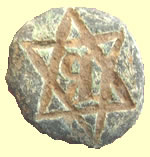 |
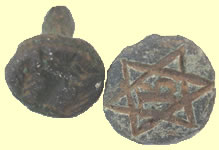 |
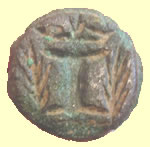 |
|
|
2- 13thC
seal matrix - Jewish symbol & capital 'R' - Initial capital 'I'
|
|||
 |
 |
 |
|
|
Eastern
Counties Railway button
|
Post
1840 Naval officers button
|
Very
unusual tiny snake buckle 17thC
|
|
 |
 |
||
|
GLORIA
EXERCITVS - 2 soldiers standing, facing, holding spears in outside
hands and leaning inside hands on shields, flanking a single legionary
standard with a chi-rho Christogram on it Info supplied by Mark
Lehman |
|||
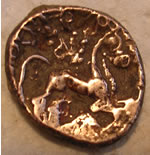 |
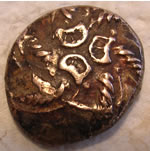 |
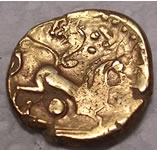 |
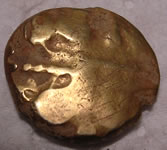 |
|
Illinois Tim's 45 BC Addedomaros Celtic gold stater 5.63g, 17.96mm CCI 05.0678 |
Chicago Ron's Celtic gold stater 'Wadden Chase' type 5.95g, 17.68 mm The Whaddon Chase stater (yes, it is that type) will be CCI 05.0680. These coins are probably not very much earlier than the Addedomaros staters - it all depends really on when one dates the Addedomaros issue. It seems fairly certain that the Whaddon Chase staters could be from the later stages of the Gallic War, say about 54 BC at the earliest; they could be a little bit later, but are unlikely to be after say 40 BC at the very latest. If Addedomaros's spiral staters are his latest stater issues, then they could be somewhere around 30-25 BC, so perhaps up to 25 years later than Whaddon Chase. It just depends where each type fits, and we don't have an exact idea. I suppose it's true to say though that there is almost certainly a minimum of ten years between them, and more likely 20. One of my colleagues recently suggested that the WC staters were issued by Cassivellaunus, to pay off Caesar during the Gallic War. They certainly seem to be found mostly in the territory of the Catuvellauni (so this one would be a bit further east than usual . The main catalogue reference for this type is VA 1476 in Van Arsdell's 'Celtic Coinage of Britain'. They're relatively common (300 or so recorded) but a lot of these are finds from the original WC hoard, found in Bucks in 1849. |
||
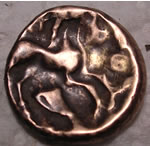 |
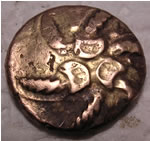 |
 |
 |
|
Ark Gary's
45 BC Addedomaros gold staters 5.55g, 16.02mm CCI
05.0679
|
Hunting
livery button
|
Spur
fragment
|
|
 |
 |
||
|
'In
your photos, I can't make out any of the obverse legend or even see
a clear profile of the portrait. My guess, from what little I can see
is that it might be Antonine-era: c. 140-180 A.D. The reverse has a
"generic" standing female personification holding a cornucopia
in her left arm, and I'm not altogether sure what she's holding in her
right. A scepter, a long torch, a caduceus, a standard - any of those
are possible, and with only a couple of letters visible, we could only
tell which personification it's meant to be by the "attributes"
- what she holds, that is. The S - C in the lower fields could be found
on just about any Imperial AE of the era - it merely means the Emperor
was paying lipservice to the powerless Senate by saying the bronze was
issued ex senatus consultio - by the permission of the Senate. Info supplied
by Mark Lehman |
|||
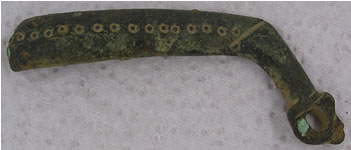 |
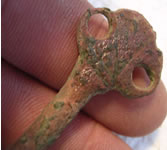 |
 |
|
|
Very unusual
decorated spur fragment - not in the reference books - Decoration suggests
that it is really early
|
17thC
clothing fastener
|
||
 |
 |
||
|
Great relic
- 18thC Brown Bess musket plate with the initial 'E' and 70 inscribed
on it
|
18thC
clothing fastener
|
||
 |
 |
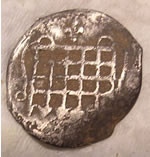 |
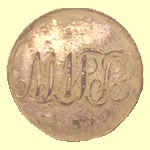 |
|
18thC cup
trade weight
|
1605 James
1st hammered silver halfpenny
|
Monogrammed
livery button
|
|
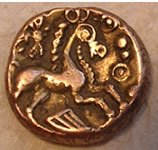 |
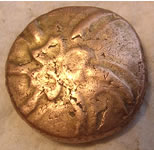 |
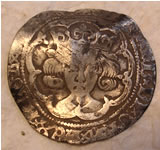 |
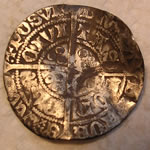 |
|
Ark Gary's
second 45 BC Addedomaros Celtic gold stater 5.50g, 16.35mm
|
Edward
IV 1464 -70 London mint - Plain cross initial mark hammered silver groat
2.63g, 25.65 mm
|
||
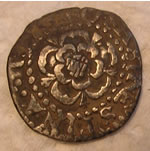 |
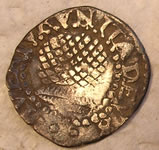 |
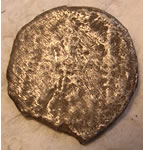 |
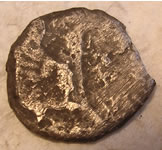 |
|
1605 James
1st hammered silver penny
|
Early Roman silver coin in rough shape sent off to Mark at the URF for a best guess 1.96g, 15.61mm 'That's
a "Legionary Denarius " of Marc Antony. |
||
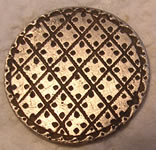 |
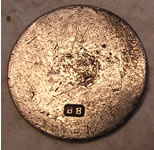 |
 |
 |
|
Great find
- solid silver Mid 18thC button with markers mark BB
|
1356-61
AD Edward III hammered silver penny 1.31g, 19.97mm
|
||
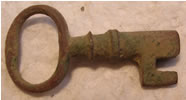 |
 |
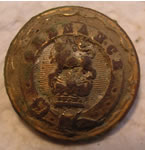 |
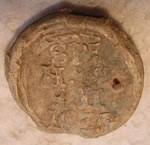 |
|
Cabinet
or draw key 19thC
|
17thC button
|
Army Ordnance
Corp button
|
1835 Russian
lead bale seal
|
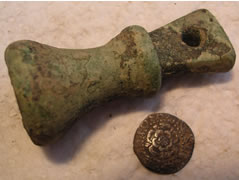 |
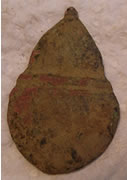 |
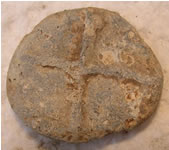 |
|
|
17thC
Charles 1st hallmarked large bell shaped trade weight
|
Post Medieval
acorn design belt mount
|
15thC long
cross lead token
|
|
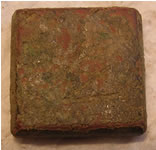 |
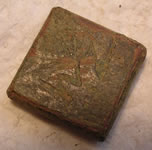 |
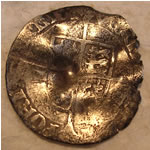 |
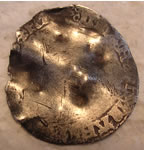 |
|
16thC Antwerp
hand coin weight
|
1553-54
Mary hammered silver groat (4 pence)
|
||
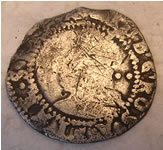 |
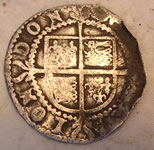 |
 |
 |
|
16thC Elizabeth
1st hammered silver half groat (2 pence)
|
1696 William
III milled silver love token
|
||

|
 |
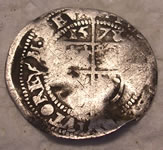 |
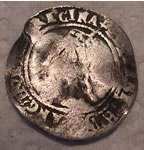 |
|
Stunning
1356 Edward III hammered silver groat (4 pence) Type F London mint 4.43g,
26.95mm
|
1578 Elizabeth
1st hammered silver half groat
|
||
 |
 |
||
|
18thC Toy
Cannon
|
18thC
Toy Cannon
|
||
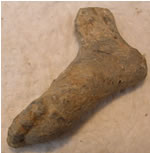 |
 |
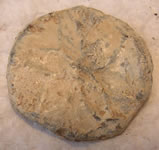 |
|
|
Neat find
- lead foot !!
|
Early 18thC
buckle
|
15thC flower
pattern lead token
|
|
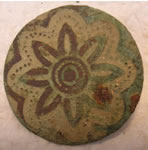 |
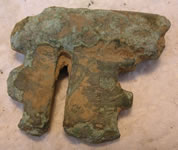 |
 |
 |
|
19thC flower
button
|
15thC bronze
door key
|
George
III London hallmark trade weight
|
18thC bell
|
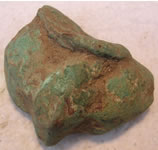 |
 |
||
|
Huge Medieval
bronze pot foot
|
Early Medieval
bridle fitting - Cheek
piece
|
||
 |
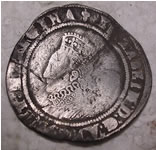 |
 |
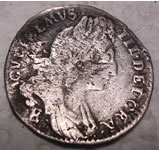 |
|
1579 Elizabeth
1st hammered silver sixpence
|
1697 William
III milled silver sixpence - small crown Exeter mint
|
||
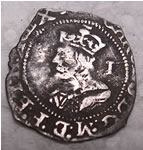 |
 |
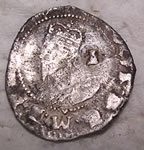 |
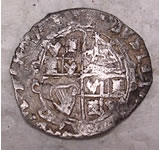 |
|
Charles 1st hammered silver one pence - 1625-42 AD Struck at the Tower mint under the King type 3a1 |
Charles
1st hammered silver one pence
|
||
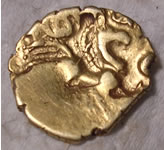 |
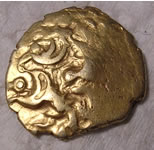 |
 |
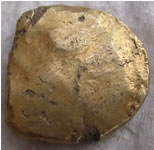 |
|
Wis Dave's 1/4 Uninscribed Celtic gold stater 1.43g, 12.98mm found by Wis Dave 'Yes, this is interesting. It's an uninscribed quarter stater, traditionally attributed to the Atrebates (in the South Thames) but almost certainly a North Thames issue. We have records of about 25 of them, and without exception they've come from the North Thames area: it was previously attributed to the Atrebates because of the style, which resembles their uninscribed quarter staters with a wreath on the obverse. The date of this quarter would be around c. 45 BC, I would estimate, so like the Whaddon Chase it could be just a little earlier than the Addedomaros coins. It is catalogued in Van Arsdell as VA 260-1, but not only wrongly as Atrebates but also listed as silver. Many of the surviving examples are struck from the same pair of dies, which develop some fairly major flaws, especially on the reverse; the lack of many dies suggests this wasn't a very big issue, in comparison to the Addedomaros spiral for example. If I remember rightly there are one or two examples of this type in the huge East Leicestershire hoards which came up about 3 years ago, but mostly they're Essex/Suffolk area. This'll be CCI 05.0683'. |
Chicago Ron's 'Snettisham' type ? Celtic gold full stater 5.85g - 17.05mm 'Having seen this one I've had to think again about 05.0680, the Whaddon Chase type I wrote about earlier. Although quite different in their individual style these are probably both the same variety of WC stater, actually listed as VA 1498. This is a rather puzzling type because it's not clear whether it really belongs to the WC group or - as you suggested - the Snettisham type. There are 18 examples of it here and those with findspots are a mixture of Essex, Suffolk and Norfolk - on that basis it could arguably be either WC or Snettisham. In terms of style, they are perhaps among the very last WC staters rather than being the first Snettisham, which appear to have been based on the Whaddon Chase design. In terms of date this might only be a difference of a few months, and almost certainly not more than a few years, so it's perhaps unreasonable to expect we'll be able to tie it down quite so neatly. CCI 05.0687'. |
||
 |
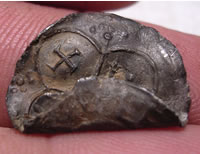 |
||
|
Coenwulf hammered silver penny - Saxon period 798AD EMC 20050226 'This is a good example of the earliest East Anglian coinage of Coenwulf (North 363). It is quite rare, as there are only two other examples of North 363 on EMC, from dies of different styles'. |
|||
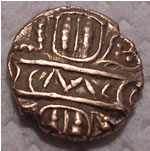 |
 |
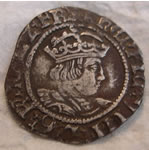 |
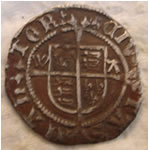 |
|
Celtic gold 1/4 stater of the Cunoblein tribe 1stC BC to 40AD.(Biga type) head facing left found by Wis Paul 1.38g, 10.89 mm 'another cracking little coin. It is the biga type as you say, still quite rare: we have just over 20 of the quarter recorded. I had hoped to have a look at the dies in comparison to the rest of the coins in Oxford this morning, but ran out of time and I'm now back in Guernsey again. That'll have to wait a while, but in the meantime it looks as though it's one of the later strikings of this type, because of the simplified CAMVL inscription on the obverse. The earliest examples have each letter very clearly defined, but they soon merge into what looks almost like a zigzag on some coins. Saying it's a 'late striking' is all relative of course: it's possible that the biga type was struck over a very short period, perhaps even just months and certainly unlikely to be more than say five years or so, sometime around 8 - 13 AD I would estimate. It'll be CCI 05.0688 |
Henry VIII hammered silver half groat 2nd coinage 1526-44AD 1.18g, 18.34mm Canterbury mint |
||
 |
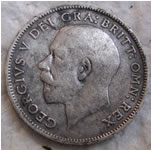 |
 |
 |
|
1915 George
V milled silver six pence
|
1800's
Victorian milled silver sixpence
|
||
 |
 |
 |
 |
|
1216
AD Henry III shortcross hammered silver penny 0.64g, 17.21mm
|
1605
James 1st hammered
silver six pence
2.86g,
25.63mm
|
||
 |
 |
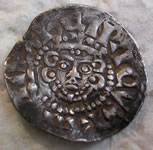 |
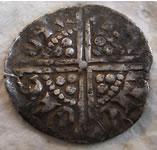 |
|
1216
AD Henry III shortcross hammered silver - fractured
|
1247 Henry III voided longcross hammered silver penny Class V5 1,33g,18.11mm |
||
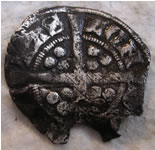 |
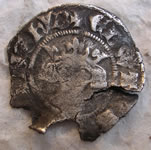 |
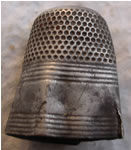 |
 |
|
1279
Edward 1st hammered silver penny
1.20g,
17.79mm
|
Mid
18thC silver thimble
|
15thC
lead long cross token
|
|
 |
 |
||
|
Rare Profile issue 1509 AD - Henry VII hammered
silver groat (4 pence)
|
|||
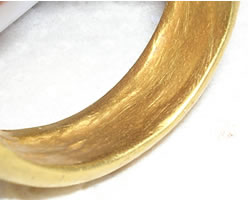 |
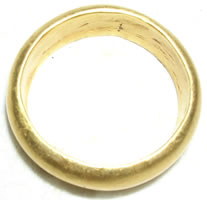 |
||
|
Chicago Bob found a monster of a gold ring which weighs in at a hefty 14.40g, 25.47mm dia. This has been reported to the museum as potential treasure and will go to the British Museum to determine it's age |
|||
 |
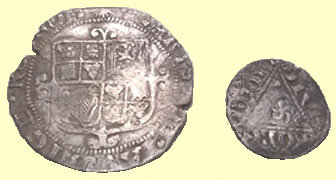 |
||
|
1642 AD Tower mint under parliament Charles 1st shilling (12 pence) 5.12g, 30.05mm 1207 AD 'Rex' issue King John Irish one pence 1.24g, 17.26mm This example is minted in Dublin and the Moneyer is Roberd |
|||
 |
 |
 |
|
|
Heart stopping
find - What appeared initially as an old gold find unfortunately is
modern as the Saxon's did not stick the pearls on their gold with super
glue LOL
|
1670 hammered copper Half penny HFR - S.R |
||
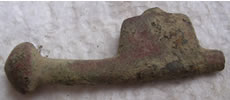 |
 |
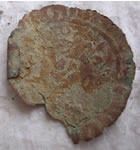 |
|
|
Post Medieval
purse bar fragment
|
16thC German
Jetton
|
||
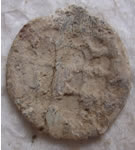 |
 |
 |
 |
|
15thC lead
'weave' pattern token
|
'It's almost certainly 3rd century by the radiate crown on the obverse - it looks nothing like a 4th century "post-reform radiate". I'm not making out any legends or the reverse type on that one, either. What is the diameter in mm? I'd say, depending on diameter, that it's either an official antoninianus from the darkest hour of the Empire - Gallienus-Claudius Gothicus - 260-270 A.D. or a contemporary (so-called "barbarous radiate", although I dislike that term - the folks who made and used them were no more barbarians than the Italians) imitative radiate' Info form Mark
at the URF. |
Post Medieval
belt mount
|
|
 |
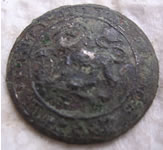 |
 |
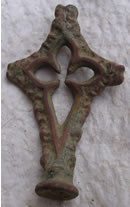 |
|
Post Medieval
belt mount
|
Military
button - not ID'd yet
|
Very interesting
17thC trade farthing with flower pattern - not researched yet
|
This is
the second of these type of crosses found that have a Medieval feel
to them.
|
 |
 |
 |
|
|
Lattern
handle spoon 16th -17thC
|
1839 Victorian
milled silver sixpence
|
||
 |
 |
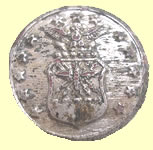 |
 |
|
Large 1stC Roman bronze 'Are there any letters at all visible in the obverse legend on the sestertius-sized piece? My only guess, and it's certainly no more than a WAG at best, is Trajan Decius, based solely on the portrait. I can't make anything recognizable resolve out of the reverse image for that one yet, either. If (and it's a big if) it is Trajan Decius, it would date to 249-251 A.D'. Info form Mark
at the URF. |
Is this
a USA button ?
|
Cocoa advertising
thimble
|
|
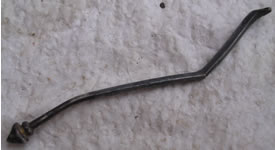 |
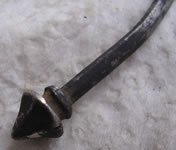 |
||
|
Diamond
knop 15thC silver spoon handle - Reported to museum as potential treasure
|
|||
 |
 |
||
|
18thC copper
alloy spoon
|
Large 18thC
working toy cannon
|
||
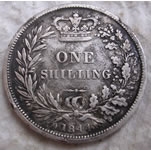 |
 |
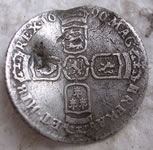 |
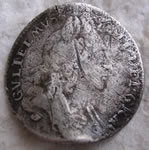 |
|
1844 Victorian
milled silver shilling
|
1696 Willian
III milled silver sixpence - early harp large crown
|
||
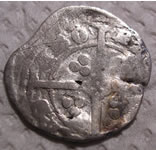 |
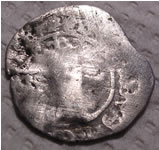 |
||
|
1272AD Edward 1st hammered silver penny 1.05g, 18.08mm |
|||
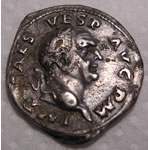 |
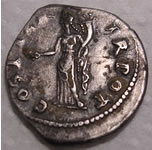 |
||
|
2.03g – 17.7mm 'obviously
don't have to tell you that this is Vespasian, but this one is so
nice and clear that I will give you chapter and verse from the standard
references - no uncertainties with this one! |
|||
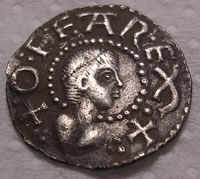 |
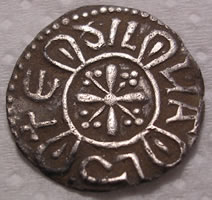 |
||
|
EMC 2005.0229 found by NY Ken King Offa - 780 - 792 King of Mercia hammered silver 1.27g, 16.67mm OFFA
REX (‘King Offa’) and, on the reverse side, Eð / IL
/ VA / Ld (‘Ethilwald’ - the moneyer who authorised the
minting of the coin). |
|||
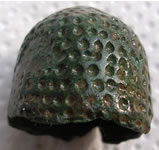 |
 |
 |
 |
|
12thC Bronze
beehive thible
|
1649 Commonwealth
hammered silver one pence
|
Colchester
and East Essex Co-op - 3 pence token
|
|
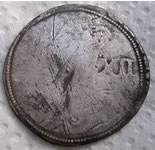 |
 |
 |
 |
|
1638-9
Charles 1st Second milled issue
silver shilling (12 pence)
|
1660
hammered trade farthing
|
||
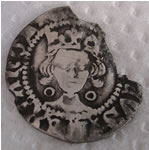 |
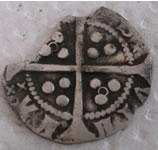 |
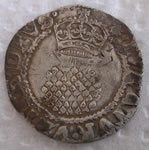 |
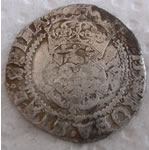 |
|
1422-7
Henry VI hammered silver penny Annulet issue Calais
|
1604-
19 James 1st
hammered silver half groat (2 pence ) Second
coinage
|
||
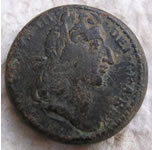 |
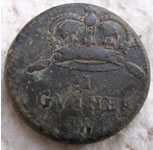 |
 |
 |
|
1696 William III 1 Gold Guinea coin weight 8.07g, 20mm dia, 3.3mm T |
Longcross
Medieval hammered silver half groat in rough shape
|
||
 |
 |
 |
|
|
16thC decorated
bronze finger ring
|
|||
 |
 |
 |
|
|
1st to 4thC Roman bronze fibula brooch - unusual design not in my reference books 4.14g, 27.42mm L, 11.62mm W |
|||
 |
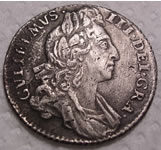 |
 |
|
|
17thC pocket sun dial fragment 50.27mm L, 11.62mm W |
1696 William
III miled silver six pence
|
||
 |
 |
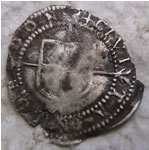 |
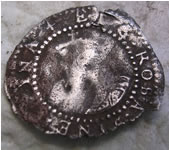 |
|
1602 Elizabeth
1st hammered silver sixpence
|
Curious
hammered silver penny - Appears to a Mary or Elizabeth 1st - 'Rosa Spine
Spina' but does not match either as it has a distinct cross above the
crown - almost like an Edward VI - needs more investigation
|
||
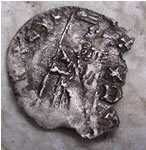 |
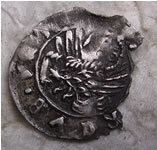 |
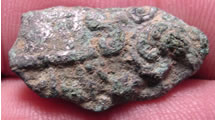 |
|
|
14thC Soldino
hammered silver coin
|
9thC Bronze
silvered Saxon strap end fragment 9.54g, 27.89mm L
|
||
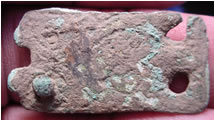 |
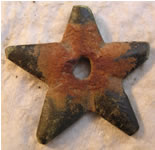 |
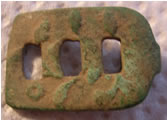 |
|
|
Medieval
decorated copper alloy clasp fastener 3.59g,30.91mm L
|
Medieval
Spur rowel
|
18thC
clog fastener
|
|
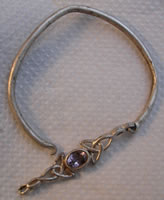 |
 |
||
|
Heart
attack find from a Roman site, handmade bracelet with stone but there
is 925 Sterling silver mark on it LOL still a great find though !
|
|||
 |
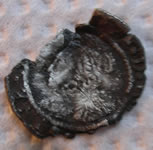 |
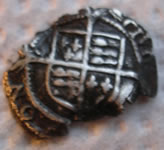 |
|
|
1892 Queen Victoria milled silver sixpence (top left) 1896 Queen Victoria milled silver three pence (bot left) 1817 George III milled silver shilling, 12 pence (right) |
1558-
1603 Elizabeth 1st hammered silver penny
|
||
 |
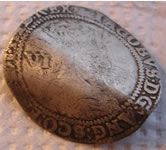 |
 |
 |
|
1603 James
1st hammered silver sixpence - first bust
|
Medieval
lead token - very unusual design- requires further investigation
|
||
 |
 |
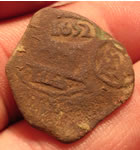 |
|
|
Post Medieval
belt mount acorn pattern
|
Interesting
strap end fragment with 17thC 'S' stamp
|
1652, 8
Maravedis revalidated with VIII counterstamp on 8 Maravedis of 1625
of uncertain mint, Felipe IV (1621-1665) of Spain
|
|
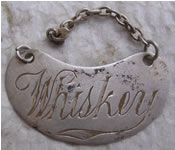 |
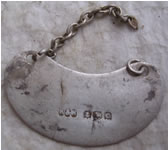 |
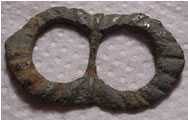 |
 |
|
Whiskey
decanter badge - Birmingham hallmark
solid silver 1927, Maker H&H
|
18thC
double D buckle
|
1660
Hammered copper trade farthing
|
|